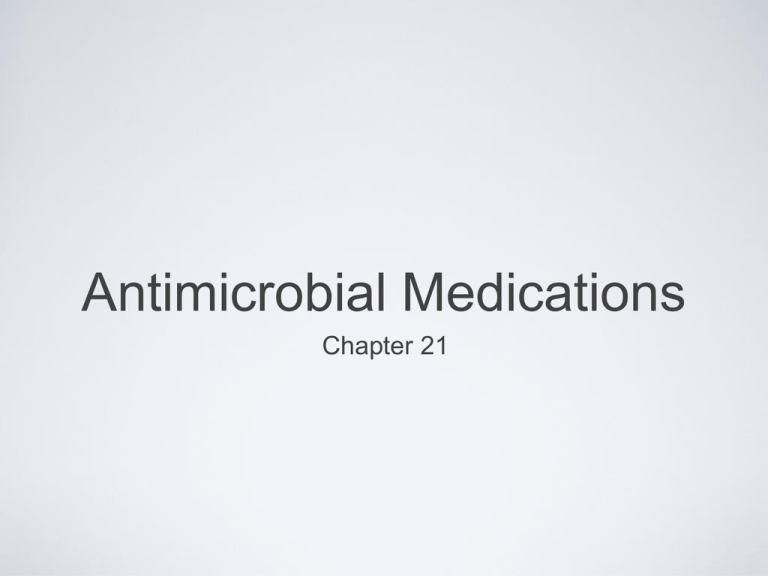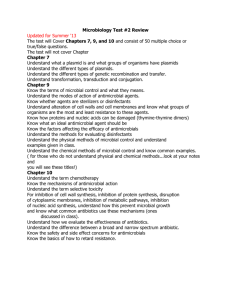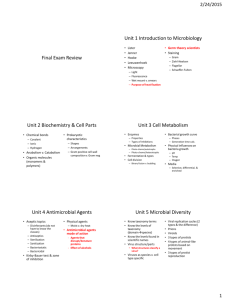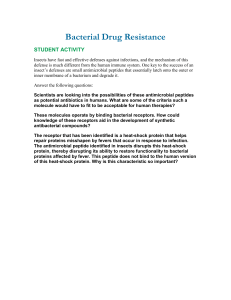Antimicrobial Medications
advertisement

Antimicrobial Medications Chapter 21 21.1 History and Development of Antimicrobial Drugs Discovery of antibiotics Alexander Fleming Discovered penicillin while working with Staphylococcus Noticed there were no Staph colonies growing near a mold contaminant The colonies appeared to be melting Identified mold as Penicillium and was producing a bactericidal substance that was effective against a wide range of microbes Fleming unable to purify compound 21.1 History and Development of Antimicrobial Drugs Discovery of antibiotics Ernst Chain and Howard Florey successfully purified penicillin In 1941 tested on human subject with life threaten Staphylococcus aureus infection Treatment effective initially Supply of penicillin ran out before disease under control Drug tested again with adequate supply Patients recovered fully Mass production of penicillin during WWII Selman Waksman isolated streptomycin from soil bacterium Streptomyces griseus 21.2 Features of Antimicrobial Drugs Most modern antibiotics come from organisms living in the soil Includes bacterial species Streptomyces and Bacillus as well as fungi Penicillium and Cephalosporium To commercially produce antibiotics Strain is inoculated into broth medium Incubated until maximum antibiotic concentration is reached Drug is extracted from broth medium Antibiotic extensively purified In some cases drugs are chemically altered to impart new characteristics Termed semi-synthetic 21.2 Features of Antimicrobial Drugs Selective toxicity Antibiotics cause greater harm to microorganisms than to human host Generally by interfering with biological structures or biochemical processes common to bacteria but not to humans Toxicity of drug is expressed as therapeutic index Lowest dose toxic to patient divided by dose typically used for treatment High therapeutic index = less toxic to patient 21.2 Features of Antimicrobial Drugs Antimicrobial action Drugs may kill or inhibit bacterial growth Inhibit = bacteriostatic Kill = bacteriocidal Bacteriostatic drugs rely on host immunity to eliminate pathogen Bacteriocidal drugs are useful in situations when host defenses cannot be relied upon to control pathogen 21.2 Features of Antimicrobial Drugs Spectrum of activity Antimicrobials vary with respect to range of organisms controlled Narrow spectrum Work on narrow range of organisms Gram positive only OR Gram negative only Broad spectrum Work on broad range of organisms Gram positive AND Gram negative Disadvantage of broad spectrum is disruption of normal flora 21.2 Features of Antimicrobial Drugs Tissue distribution, metabolism and excretion Drugs differ in how they are distributed, metabolized and excreted Important factor for consideration when prescribing Rate of elimination of drug from body expressed in half-life Time it takes for the body to eliminate one half the original dose in serum Half-life dictates frequency of dosage Patients with liver or kidney damage tend to excrete drugs more slowly 21.2 Features of Antimicrobial Drugs Effects of combinations of antimicrobial drugs Combination some times used to treat infections When action of one drug enhances another, effect is synergistic When action of one drug interferes with another, effect is antagonistic When effect of combination is neither synergistic or antagonistic, effect said to be additive 21.2 Features of Antimicrobial Drugs Adverse effects Allergic reactions Allergies to penicillin Toxic effects Aplastic anemia Body cannot make RBC or WBC Suppression of normal flora Antibiotic associated colitis Antimicrobial resistance 21.3 Mechanisms of Action of Antibacterial Drugs Mechanism of action include: Inhibition of cell wall synthesis Inhibition of protein synthesis Inhibition of nucleic acid synthesis Inhibition of metabolic pathways Interference with cell membrane integrity Interference with essential processes of M. tuberculosis 21.3 Mechanisms of Action of Antibacterial Drugs Inhibition of Cell wall synthesis Bacteria cell wall unique in construction Contains peptidoglycan Antimicrobials that interfere with the synthesis of cell wall do not interfere with eukaryotic cell These drugs have very high therapeutic index Low toxicity with high effectiveness Antimicrobials of this class include β lactam drugs Vancomycin Bacitracin 21.3 Mechanisms of Action of Penicillins and cephalosporins Antibacterial Drugs Part of group of drugs called β – lactams Competitively inhibits function of penicillin-binding proteins Inhibits peptide bridge formation between glycan molecules Drugs vary in spectrum Some more active against Gram (+) Some more active against Gram (-) Some organisms resist effects through production of β-lactamase enzyme Enzyme breaks β-lactam ring 21.3 Mechanisms of Action of Antibacterial Drugs Vancomycin Inhibits formation of glycan chains Inhibits formation of PTG and cell wall construction Does not cross lipid membrane of Gram (-) Important in treating infections caused by penicillin resistant Gram (+) organisms Must be given intravenously due to poor absorption from intestinal tract 21.3 Mechanisms of Action of Antibacterial Drugs Inhibition of protein synthesis Structure of prokaryotic ribosome acts as target for many antimicrobials of this class Differences in prokaryotic and eukaryotic ribosomes responsible for selective toxicity Drugs of this class include Aminoglycosides Tetracyclins Macrolides Chloramphenicol Lincosamides Oxazolidinones Streptogramins 21.3 Mechanisms of Action of Antibacterial Drugs 21.3 Mechanisms of Action of Antibacterial Drugs Tetracyclins Reversibly bind 30S ribosomal subunit Blocks attachment of tRNA to ribosome Effective against certain Gram (+) and Gram (-) Newer tetracyclines such as doxycycline have longer half-life Resistance due to decreased accumulation by bacterial cells Can cause discoloration of teeth if taken as young child 21.3 Mechanisms of Action of Antibacterial Drugs Inhibition of nucleic acid synthesis These include Fluoroquinolones Rifamycins 21.3 Mechanisms of Action of Antibacterial Drugs Rifamycins Block prokaryotic RNA polymerase Block initiation of transcription Rifampin most widely used rifamycins Effective against many Gram (+) and some Gram (-) as well as members of genus Mycobacterium Primarily used to treat tuberculosis as well as preventing meningitis after exposure to N. meningitidis Resistance due to mutation coding RNA polymerase Resistance develops rapidly 21.4 Determining Susceptibility of Bacterial to Antimicrobial Drug Susceptibility of organism to specific antimicrobials is unpredictable Often drug after drug tried until favorable response was observed If serious infection, several drugs were prescribed at one time with hope that one was effective Better approach determine susceptibility Prescribe drug that acts against offending organism Best to choose one that affects as few others as possible 21.4 Determining Susceptibility of Bacterial to Antimicrobial Drug Determining MIC MIC = Minimum Inhibitory Concentration Quantitative test to determine lowest concentration of specific antimicrobial drug needed to prevent growth of specific organism Determined by examining strain’s ability to grow in broth containing different concentrations of test drug 21.4 Determining Susceptibility of Bacterial to Antimicrobial Drug MIC is determined by producing serial dilutions with decreasing concentrations of test drug Known concentrations of organism is added to each test tube Tubes are incubated and examined for growth Growth determined by turbidity of growth medium Lowest concentration to prevent growth is MIC 21.4 Determining Susceptibility of Bacterial to Antimicrobial Drug Conventional disc diffusion method Kirby-Bauer disc diffusion routinely used to qualitatively determine susceptibility Standard concentration of strain uniformly spread of standard media Discs impregnated with specific concentration of antibiotic placed on plate and incubated –Clear zone of inhibition around disc reflects susceptibility •Based on size of zone organism can be described as susceptible or resistant 21.5 Resistance to Antimicrobial Drugs Mechanisms of resistance Drug inactivating enzymes Some organisms produce enzymes that chemically modify drug Penicillinase breaks β-lactam ring of penicillin antibiotics Alteration of target molecule Minor structural changes in antibiotic target can prevent binding Changes in ribosomal RNA prevent macrolides from binding to ribosomal subunits 21.5 Resistance to Antimicrobial Drugs Acquisition of resistance Can be due to spontaneous mutation Alteration of existing genes Spontaneous mutation called vertical evolution Or acquisition of new genes Resistance acquired by transfer of new genes called horizontal transfer 21.5 Resistance to Antimicrobial Drugs • Staphylococcus aureus Common cause of nosocomial infections Becoming increasingly resistant In past 50 years most strains acquired resistance to penicillin Due to acquisition of penicillinase genes Until recently most infections could be treated with methicillin (penicillinase resistant penicillin) Many strains have become resistant MRSA methicillin resistant Staphylococcus aureus Many of these strains still susceptible to vancomycin Some hospitals identified VISA VISA vancomycin intermediate Staphylococcus aureus 21.5 Resistance to Antimicrobial Drugs • Streptococcus pneumoniae Has remained sensitive to penicillin Some strains have now gained resistance Resistance due to modification in genes coding for penicillin-binding proteins Changes due to acquisition of chromosomal DNA from other strains of Streptococcus Generally via DNA mediated transformation 21.5 Resistance to Antimicrobial Drugs Slowing emergence and spread of resistance Responsibilities of physicians and healthcare workers Increase efforts to prescribe antibiotics for specific organisms Educate patients on proper use of antibiotics Responsibilities of patients Follow instructions carefully Complete prescribed course of treatment Misuse leads to resistance 21.6 Mechanisms of Action of Antiviral Drugs Available antiviral drugs effective specific type of virus None eliminate latent virus Targets include Viral uncoating Nucleoside analogs Non-nucleoside polymerase inhibitors Non-nucleoside reverse transcriptase inhibitors Protease inhibitors Neuraminidase inhibitors








